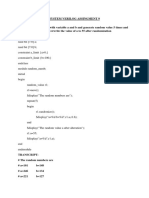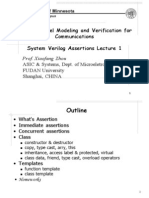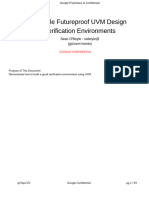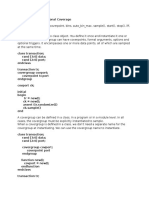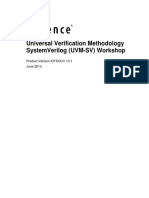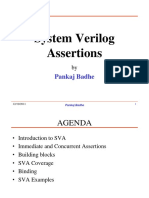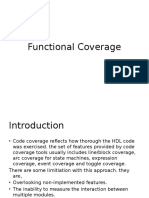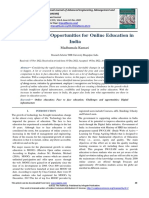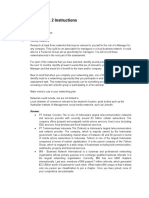ASIC Verification
Randomization 2
�Topics
Controlling Constrains
Controlling Random Variables
Array Constraints
Scenario Generation
Random Device Configuration
�Controlling Constraints
In-line Constraints
SV allows you to add an extra constraint to any existing ones in
effect using randomize()with
class Transaction;
rand bit [31:0] addr, data;
constraint c1{addr inside {[0:100],[1000:2000]};}
endclass
in-line constraint
Transaction t;
initial begin
t=new();
assert(t.randomize() with {addr>=50; addr<=1500; data<10;});
driveBus(t);
assert(t.randomize() with {addr==2000; data>10;});
driveBus(t);
end
randomize() with statement
�Controlling Constraints
Constraint with variablesBy changing the variable
max_size you can vary the
upper limit
Creates random sizes
between 1 and 100
class Bounds;
rand int size;
int max_size=100;
constraint c_size{size inside {[1:max_size]};}
endclass
Using random variables
�Controlling Constraints
Controlling constraints with constraint_mode()
Can be used to control whether a constraint is active or inactive
When a constraint is inactive it is not considered by randomize()
All constraints are initially active
constraint_mode method is built in and cannot be overridden
Value
Meaning
Description
OFF
Sets the specified constraint block to inactive so that it is not enforced by
subsequent calls to randomize() method
ON
Sets the specified constraint block to active so that it is considered by
subsequent calls to randomize() method
�Controlling Constraints
Controlling multiple constraint blocks
A class may contain multiple constraints
At run time you can use constraint_mode() routine to turn
constrains on and off
To control all constraints in an object use
handle.constraint_mode()
A single constraint can be controlled with
handle.constraint.constraint_mode()
�Controlling Constraints
Controlling multiple constraint blocks
class Packet;
rand int length;
constraint c_short{length inside {[1:32]};}
constraint c_long{length inside {[1000:1023]};}
endclass
Create long packets by
Packet p;
disabling short constraint
initial begin
p=new();
p.c_short.constraint_mode(0);
assert(p.randomize());
transmit(p);
p.constraint_mode(0);
p.c_short.constraint_mode(1);
assert (p.randomize());
transmit (p);
end
Using constraint_mode
Create short packets by
disabling all constraints
and enabling only the
short constraint
�Controlling Constraints
Specifying a constraint in a test with external constraints
Body of constraint can be defined outside the class
This allows data class to be defined in one file with an empty
constraint
This enables each test to define its own version of this constraint to
generate its own flavors of stimulus
Can only add constraints and not alter existing ones
class Packet;
rand bit [7:0] length;
rand bit [7:0] payload[];
constraint c_valid {length>0; payload.size()==length;}
constraint c_external;
endclass
program test
constraint Packet::c_external {length==1;}
end
Class and Program with an external constraint
�Disabling Random Variables
Disabling random variables with rand_mode()
Can be used to control whether a random variable is active or inactive
When a random variable is inactive it implies that the variable was never declared
rand or randc
rand_mode() method is inbuilt and cannot be overridden
Value
Meaning
Description
OFF
Sets the specified variable to inactive so that they are not randomized on
subsequent calls to randomize() method
ON
Sets the specified variable to active so that they are randomized on
subsequent calls to randomize() method
class Packet;
rand integer src, dst;
endclass
int r;
Packet packet_a=new();
packet_a.rand_mode(0);
packet_a.src.rand_mode(1);
r=packet_a.dst.rand_mode();
�Controlling Random Variables
Using non random values: rand_mode()
class Packet;
rand bit[7:0] length, payload[];
constraint c_valid{legth >0 ; payload.size()==length;}
endclass
intial begin
Packet p;
p.lenght.rand_mode(0);
p.length=42;
assert(p.randomize());
end
Make length non random
Set length to a constant value
Randomize the payload
Using rand_mode() to disable variabes
�Controlling Random Variables
Randomizing individual variables
To randomize a few variables inside a class, randomize() can be
called with the subset of variables
Only the variables passed in the argument are randomized
The rest of the variables are not randomized
The constraints remain in effect
class Rising;
byte low;
rand byte med, hi;
constraint up {low<med; med<hi}
endclass
initial begin
Rising r;
r=new();
r.randomize();
r.randomize(med);
r.randomize(low);
end
Randomization of a subset of variables in a class
�Iterative and Array Constraints
Array Size
class dyn_size;
rand logic [31:0] d[];
constraint d_size {d.size() inside {[1:10]};}
endclass
Constraining dynamic size array
�Iterative and Array Constraints
Example
You have an interface that has to transfer 4 data words
The words can be transferred consecutively or over 10 cycles
A strobe signal will tell you when data is ready to be transferred
Random Strobe Pattern
�Iterative and Array Constraints
Example
parameter MAX_TRANSFER_LEN=10;
class StrobePat;
rand bit strobe[MAX_TRANSFER_LEN];
constraint c_set_four {strobe.sum()==4h4;}
endclass
intial begin
StrobePat sp;
int count=0;
sp=new();
assert(sp.randomize());
foreach (sp.strobe[i]) begin
@bus.cb
bus.cb.strobe<=sp.strobe[i];
if(sp.strobe[i])
bus.cb.data<=data[count++];
end
end
Random Strobe Pattern
�Iterative and Array Constraints
Constraining Individual Array and Queue Elements
An array of unsigned integers
Each entry should be between 1 and 255
The array should have between 1 to 8 elements
All those elements to add up to less than 1024
class good_sum;
rand unint len[];
constraint c_len {foreach (len[i])
len[i] inside {[1:255]};
len.sum<1024;
len.size() inside {[1:8]};}
endclass
Simple foreach constraint
�Scenario Generation
Scenario Generation using randsequence
So far we have seen atomic stimulus generation
Verifying a design in the real-world stimuli needs long sequences of
transactions
Can make a single bus transaction, a single network packet or a single processor
instruction
DMA transfers
Cache fills
Network traffic due to browsing internet, reading e-mails etc.
Deep pipelines for processors
Use randsequence SystemVerilog constructs to generate a sequence of
transactions
�Scenario Generation
Scenario Generation using randsequence
When main is chosen it
generates the sequence
first, second and done
Second chooses
between pop or push
randsequence( main )
main: first second done ;
first: add | dec ;
second: pop | push ;
done: { $display("done"); };
add: { $display("add"); };
dec: { $display("dec"); };
pop: { $display("pop"); };
push: { $display("push"); };
endsequence
Example of randsequence
add
add
dec
dec
pop done
push done
pop done
push done
Possible Outcomes
First chooses between
add or dec
�Scenario Generation
Scenario Generation using randsequence
Stream can be either
cfg_read, io_read or
mem_read with the
respective weights
Either a single call to
cfg_read task or multiple
calls
initial begin
for(int i=0; i<15; i++) begin
randsequence (stream)
stream : cfg_read:=1|
io_read:=2|
mem_read:=5;
cfg_read: {cfg_read_task;}|
{cfg_read_task;} cfg_read;
mem_read: {mem_read_task;}|
{mem_read_task;} mem_read;
io_read: {io_read_task;}|
{io_read_task;} io_read;
endsequence
end
end
Command generator using randsequence
�Random Device Configuration
Example of Creating Random Testbench Configuration
class eth_cfg;
rand bit
rand bit
rand bit
rand int
[ 3:0] in_use; // Ports used in test
[47:0] mac_addr[4]; // MAC addresses
[ 3:0] is_100;// 100mb mode
run_for_n_frames;// # frames in test
// Force some addr bits when running in unicast mode
constraint local_unicast {
foreach (mac_addr[i])
mac_addr[i][41:40] == 2'b00;}
constraint reasonable {// Limit test length
run_for_n_frames inside {[1:100]};}
endclass : eth_cfg
Ethernet Switch Configuration Class
�Random Device Configuration
Building Environment with Random Configuration
Class Environment
eth_cfg cfg;
eth_src gen[4];
eth_mii drv[4];
function new();
cfg=new();
endfunction
function void gen_cfg;
assert(cfg.randomize());
endfunction
function void build();
foreach (gen[i])
if(cfg.in_use[i]) begin
gen[i]=new();
drv[i]=new();
if (cfg.is_100[i])
drv[i].set_speed(100);
end
endfunction
task run();
foreach(gen[i])
if(cfg.in_use[i] begin
gen[i].run();
.
end
endtask
task wrap_up();
endtask
endclass
Building environment with random configurations
�Random Device Configuration
Building Environment with Random Configuration
program test;
Environment env;
initial begin
Construct environment
env=new();
Create random configurations
env.gen_cfg;
Build the testbench environment
env.build();
Run the test
env run();
Clean up after test and report
env.wrap_up();
end
endprogram
Simple test using random configurations
�Thank You

